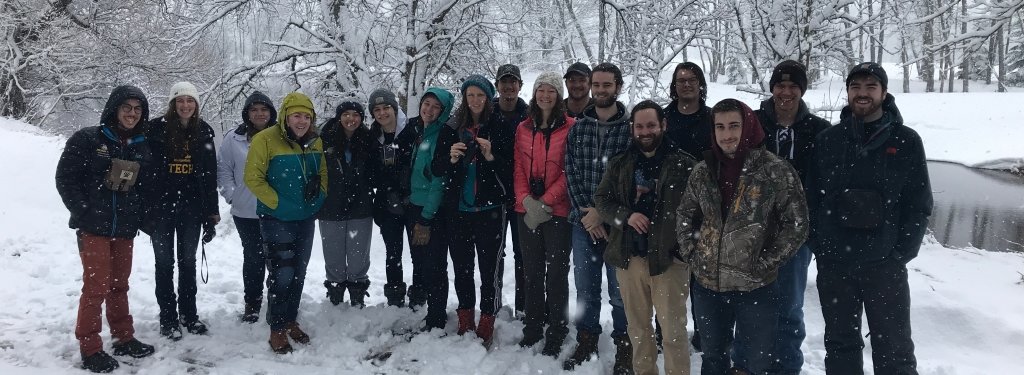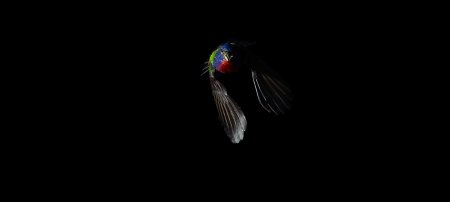Ornithologist and ecologist David Flaspohler discovers an old book and reflects on its owner, Gene Hesterberg, and its importance today.
April 11, 1940.
The date was neatly written in tiny sepia-colored ink in the top-right corner inside the cover of a worn blue book. Andrea Longhini had seen it during the building remodeling, and recognized it as something too special for the school’s “give away” table. I picked up the 4 x 8-inch hardcover book bound in stained blue canvas, heavily used, with old cloth tape holding together the last scraps of the book’s paper jacket. It was an original Roger Tory Peterson Field Guide, customized with homemade tabs peeking out from the pages with family names including “Diving Ducks,” “Hawks, Vultures” and “Warblers.” In the same chestnut brown, old-fashioned cursive script: “Gene A. Hesterberg” written inside the cover.

For a School of Forest Resources and Environmental Sciences alumni of a sufficient age, Gene needs no introduction. His teaching and mentoring of our students remain legendary. When I joined the faculty here in 1998, I heard his name frequently and saw him periodically at holiday and retirement parties. On a few lucky occasions, we chatted about the School, our students, and, of course, about birds and ornithology. One story I remember involved an ornithology field trip to Seney National Wildlife Refuge, 180 miles from Houghton with the students huddled under a tarpaulin in the back wooden platform of a stake truck.
He was trained as a forester at Purdue University and received his Ph.D. from the University of Michigan on June 11, 1955. He won the Distinguished Teaching Award in 1980, and on Oct. 6, 2000, had his name forever attached to the new forestry building. Gene died in September 2010. In addition to forestry classes, Gene taught ornithology, a class I began teaching in 1998.
I thumbed through the little blue book in my hand and imagined Gene on the frosty mornings and sweltering buggy June afternoons in the forests, fields and wetlands of the Upper Peninsula (UP). This was a book that had clearly spent time outdoors with its owner in a lot of special places. Perhaps some books, like certain dog breeds and people, are made for an outdoor life, not a comfortable space on a library shelf. The scars and stains were earned from long service in the coat pocket, the back pack and the passenger seat of Professor Hesterberg.

As I leafed through his field guild, with Gene’s tiny, neatly printed text next to Peterson’s simple mostly black-and-white paintings, I felt a web of connections reaching back into history, geography and biology. Here was the book Gene carried with him to remote and storied birding spots in the western UP, likely some of the same destinations where I have taken 20 years of ornithology students: Arnheim, Sturgeon River Road, McLain State Park, Big Traverse Bay, Brockway Mountain. It got me thinking about what has changed and what remains.
April 11, 1940.
I expect that if you asked an historian for a quick ranking of the changes in our world since 1940, birdlife would be well down the list after the atomic bomb, plastic and Apollo 11. Perhaps this is as it should be.
Yet in this span, the birds that share this planet with us have absorbed a quadrupling of the human population and the subsequent loss and degradation of the ecosystems that sustain them. In 1940, with legal protection from the Endangered Species Act still 33 years away, some North American birds faced crises stemming from forces as diverse as hunting, logging, wetland drainage and agricultural intensification. Gene’s field guide contained entries for Bachman’s Warbler, now known to be extinct, but in the book, Peterson surprisingly makes no reference to its decline. For the Ivory-billed Woodpecker, Peterson wrote: “Range: Extremely rare; still found in primeval forests of S.C., Fla., and La.” Peterson’s entry for the Carolina Paroquet (now known as the Carolina parakeet) is particularly poignant: “Although it is years since the last paroquet was definitely reported in the South, there is still a bare chance that a stray individual or a flock might turn up. Adults would be about the size of a Mourning Dove, with a similar pointed tail, bright green with a yellow head deepening into orange about the base of the bill.” Would be. The tiny spark of hope in Peterson’s choice of words seemed to me wildly optimistic; the last confirmed wild paroquet sighting was in 1920, and the large flocks were gone by the 1890s. For Peterson and others at the middle of the 20th century, there was a growing recognition that North America was experiencing not just a decline in numbers but rather in whole species.

If Peterson was in hopeful denial about paroquets, his brief description of the Eskimo Curlew reveals a blunt recognition of apparent inevitability: “Nearly extinct. There are recent sight records.” Extinction is typically only confirmed by long decades with an absence of sightings. All four of these once-common North American birds are now certainly extinct: a warbler, parrot, pigeon, and a sandpiper. The Passenger Pigeon did not even warrant a separate description in 1939, but is mentioned only within the paragraph devoted to the Mourning Dove: “The Passenger Pigeon is now pretty definitely known to be extinct, but still reports of individuals seen are brought to our attention.”
In the spring of 1940, Ivory-billed Woodpeckers could still be found in the bottomland forests of the southern US. Dozens of bird species that had recovered in part from unregulated market hunting in the early 1900s, would soon face new threats from post-war pesticides like DDT. Peregrine Falcons would disappear entirely from eastern North America and Bald Eagles, our national bird, would decline to the point where a siting in the 1960s would be worth noting in local papers, like the visit of an out-of-town celebrity.
April 11, 1940.
As anyone who has spent a few springs in the Keweenaw can attest, mid-April can alternate between cold and snowy and snowy and cold. Eventually, however, what the season always brings by this date, even with plenty of snow still left to melt, are new birds migrating northward. By the middle of April, White-throated and Fox Sparrows arrive singing their lovely musical songs, followed by ducks, grackles and robins. It is a time of hope and renewal after our lovely but stubbornly long winters. Birds return each year like a fulfilled promise and I can imagine that Gene experienced this reassuring rhythm and enjoyed sharing it with his students as much as I do each spring. Alongside these thoughts was the realization that the spring of 1940 was the beginning of one of the darkest periods in modern human history. Overseas, WWII was already underway with Germany occupying Poland. On April 9, two days before the date Gene inscribed in his field guide, Germany had invaded Denmark and Norway, something he must have known from headlines in the Daily Mining Gazette. Within a month, Germany would invade France, igniting five more years of war, suffering and unimaginable catastrophe.
Yet here was this lovely book in its sky-blue cover, owned by a gentle man who dedicated his life to enlightening and educating students. Here too in his own hand was a neatly written date that in many profound ways, marked a turning point in modern political and conservation history. The little blue book by Roger Tory Peterson had the modest ambition of making the beauty and grace of birds accessible to a wider public. And here was Gene Hesterberg in the spring of 1940, likely excited about his new field guide, crafting his custom canvas tabs in a world that had not yet encountered atomic bombs or even plastic, carefully penning notes alongside Peterson’s plates of phalaropes and phoebes, cormorants and cardinals. And just at the moment when a conflagration was about to engulf much of the world, Gene was himself learning about and teaching our students to identify, understand, appreciate the songs, colors, behavior of birds.
Nature has always offered solace to humans facing despair. Anyone watching the tenacity of a chickadee searching for food in the depths of a UP winter, or the audacious bravery of a female ruffed grouse defending its young can sense empathy and inspiration. Most birds live lives marked by an intense struggle for food, space and the demands of their young. Because of us, they face many new challenges in this struggle including window collisions, outdoor cats and habitat degradation. Although we will never see a Carolina Parakeet or Passenger Pigeon, more than 10,000 bird species remain worldwide to be treasured and enjoyed, and to enrich our lives.
A field guide, like a favorite novel read over and over, becomes a deeply personal object imbued with memories, notes, coffee stains, and dog eared from ten thousand fond thumbings. Gene’s was a field guide from the earliest days of modern ornithology from a pioneer forester who thought that birds, as well as trees, were worth knowing. It was a time capsule preserving a snapshot of North American bird conservation history and a marker of a tipping point in time when human life and the planet itself was about to change forever.
Like me, Gene came to Houghton as an outsider, yet grew to love the geography and people to the point where, as he told me once, “wild horses couldn’t have dragged him away.” We can be confident that the dawn chorus that greeted Gene in 1940 is the same one we can enjoy on June mornings in 2019; for that matter, it was the essentially the same bird song chorus that rang out for ten thousand springs among the Great Lakes Anishinaabe and their ancestors. Such gifts should never be taken for granted. If we take the time to listen and watch and understand the life around us, these are the threads of connection that bind us with others through history and offer some peace and calm in a world so often full of discord. Roger Tory Peterson summed up a similar sentiment when he wrote:
"The truth of the matter is, the birds could very well live without us, but many – perhaps all – of us would find life incomplete, indeed almost intolerable without the birds."
Michigan Technological University is a public research university founded in 1885 in Houghton, Michigan, and is home to nearly 7,500 students from more than 60 countries around the world. Consistently ranked among the best universities in the country for return on investment, Michigan’s flagship technological university offers more than 120 undergraduate and graduate degree programs in science and technology, engineering, computing, forestry, business, health professions, humanities, mathematics, social sciences, and the arts. The rural campus is situated just miles from Lake Superior in Michigan's Upper Peninsula, offering year-round opportunities for outdoor adventure.








Comments